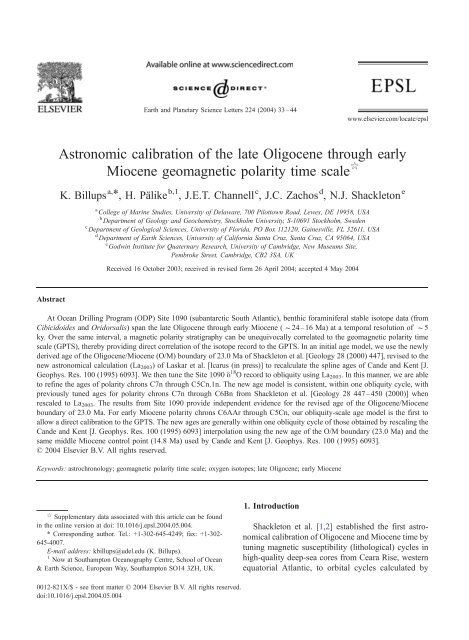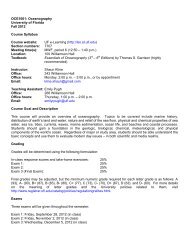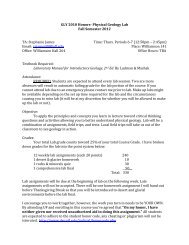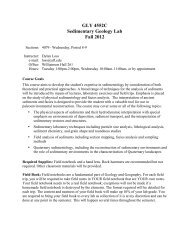Astronomic calibration of the late Oligocene through early Miocene ...
Astronomic calibration of the late Oligocene through early Miocene ...
Astronomic calibration of the late Oligocene through early Miocene ...
- No tags were found...
You also want an ePaper? Increase the reach of your titles
YUMPU automatically turns print PDFs into web optimized ePapers that Google loves.
Earth and Planetary Science Letters 224 (2004) 33–44www.elsevier.com/locate/epsl<strong>Astronomic</strong> <strong>calibration</strong> <strong>of</strong> <strong>the</strong> <strong>late</strong> <strong>Oligocene</strong> <strong>through</strong> <strong>early</strong><strong>Miocene</strong> geomagnetic polarity time scale $K. Billups a, *,H.Pälike b,1 , J.E.T. Channell c , J.C. Zachos d , N.J. Shackleton ea College <strong>of</strong> Marine Studies, University <strong>of</strong> Delaware, 700 Pilottown Road, Lewes, DE 19958, USAb Department <strong>of</strong> Geology and Geochemistry, Stockholm University, S-10691 Stockholm, Swedenc Department <strong>of</strong> Geological Sciences, University <strong>of</strong> Florida, PO Box 112120, Gainesville, FL 32611, USAd Department <strong>of</strong> Earth Sciences, University <strong>of</strong> California Santa Cruz, Santa Cruz, CA 95064, USAe Godwin Institute for Quaternary Research, University <strong>of</strong> Cambridge, New Museums Site,Pembroke Street, Cambridge, CB2 3SA, UKReceived 16 October 2003; received in revised form 26 April 2004; accepted 4 May 2004AbstractAt Ocean Drilling Program (ODP) Site 1090 (subantarctic South Atlantic), benthic foraminiferal stable isotope data (fromCibicidoides and Oridorsalis) span <strong>the</strong> <strong>late</strong> <strong>Oligocene</strong> <strong>through</strong> <strong>early</strong> <strong>Miocene</strong> ( f24–16 Ma) at a temporal resolution <strong>of</strong> f5ky. Over <strong>the</strong> same interval, a magnetic polarity stratigraphy can be unequivocally corre<strong>late</strong>d to <strong>the</strong> geomagnetic polarity timescale (GPTS), <strong>the</strong>reby providing direct correlation <strong>of</strong> <strong>the</strong> isotope record to <strong>the</strong> GPTS. In an initial age model, we use <strong>the</strong> newlyderived age <strong>of</strong> <strong>the</strong> <strong>Oligocene</strong>/<strong>Miocene</strong> (O/M) boundary <strong>of</strong> 23.0 Ma <strong>of</strong> Shackleton et al. [Geology 28 (2000) 447], revised to <strong>the</strong>new astronomical calculation (La 2003 ) <strong>of</strong> Laskar et al. [Icarus (in press)] to recalcu<strong>late</strong> <strong>the</strong> spline ages <strong>of</strong> Cande and Kent [J.Geophys. Res. 100 (1995) 6093]. We <strong>the</strong>n tune <strong>the</strong> Site 1090 y 18 O record to obliquity using La 2003 . In this manner, we are ableto refine <strong>the</strong> ages <strong>of</strong> polarity chrons C7n <strong>through</strong> C5Cn.1n. The new age model is consistent, within one obliquity cycle, withpreviously tuned ages for polarity chrons C7n <strong>through</strong> C6Bn from Shackleton et al. [Geology 28 447–450 (2000)] whenrescaled to La 2003 . The results from Site 1090 provide independent evidence for <strong>the</strong> revised age <strong>of</strong> <strong>the</strong> <strong>Oligocene</strong>/<strong>Miocene</strong>boundary <strong>of</strong> 23.0 Ma. For <strong>early</strong> <strong>Miocene</strong> polarity chrons C6AAr <strong>through</strong> C5Cn, our obliquity-scale age model is <strong>the</strong> first toallow a direct <strong>calibration</strong> to <strong>the</strong> GPTS. The new ages are generally within one obliquity cycle <strong>of</strong> those obtained by rescaling <strong>the</strong>Cande and Kent [J. Geophys. Res. 100 (1995) 6093] interpolation using <strong>the</strong> new age <strong>of</strong> <strong>the</strong> O/M boundary (23.0 Ma) and <strong>the</strong>same middle <strong>Miocene</strong> control point (14.8 Ma) used by Cande and Kent [J. Geophys. Res. 100 (1995) 6093].D 2004 Elsevier B.V. All rights reserved.Keywords: astrochronology; geomagnetic polarity time scale; oxygen isotopes; <strong>late</strong> <strong>Oligocene</strong>; <strong>early</strong> <strong>Miocene</strong>$Supplementary data associated with this article can be foundin <strong>the</strong> online version at doi: 10.1016/j.epsl.2004.05.004.* Corresponding author. Tel.: +1-302-645-4249; fax: +1-302-645-4007.E-mail address: kbillups@udel.edu (K. Billups).1 Now at Southampton Oceanography Centre, School <strong>of</strong> Ocean& Earth Science, European Way, Southampton SO14 3ZH, UK.1. IntroductionShackleton et al. [1,2] established <strong>the</strong> first astronomical<strong>calibration</strong> <strong>of</strong> <strong>Oligocene</strong> and <strong>Miocene</strong> time bytuning magnetic susceptibility (lithological) cycles inhigh-quality deep-sea cores from Ceara Rise, westernequatorial Atlantic, to orbital cycles calcu<strong>late</strong>d by0012-821X/$ - see front matter D 2004 Elsevier B.V. All rights reserved.doi:10.1016/j.epsl.2004.05.004
K. Billups et al. / Earth and Planetary Science Letters 224 (2004) 33–44 35<strong>of</strong> Delaware (see Table 1 in <strong>the</strong> online version <strong>of</strong> thisarticle). The y 13 C and y 18 O values are calibrated toVPDB via NBS-19 and in-house standards (CararraMarble). Replicate analyses <strong>of</strong> standards in <strong>the</strong> sizerange <strong>of</strong> <strong>the</strong> samples suggest that our overall (i.e.,Billups et al. [14] and this study) analytical precisionis better than 0.07x for y 13 C and 0.08x for y 18 O.Based on duplicate analyses (n = 34), we note a small<strong>of</strong>fset (0.14 F 0.23x) between <strong>the</strong> oxygen isotopedata first generated at UCSC and <strong>late</strong>r at HU [14].Although <strong>the</strong> small <strong>of</strong>fset is not statistically significant,we apply a correction <strong>of</strong> 0.14x to <strong>the</strong> recordgenerated at HU. There are no <strong>of</strong>fsets between <strong>the</strong>portions <strong>of</strong> <strong>the</strong> record generated at Santa Cruz andDelaware (n = 30).Due to <strong>the</strong> scarcity <strong>of</strong> benthic foraminifera, a highresolutionrecord can only be constructed by usingseveral species <strong>of</strong> Cibicidoides (Cibicidoides preamundulus,Cibicidoides dickersoni, Cibicidoideseocaenus and Cibicidoides havanensis) in addition toCibicidoides mundulus and by combining <strong>the</strong>m withOridorsalis umbonatus. Oridorsalis y 13 C values aregenerally not used for paleoceanographic reconstructionsbecause this genus has an infaunal habitat andy 13 C values do not reflect <strong>the</strong> y 13 C <strong>of</strong> dissolvedinorganic carbon at <strong>the</strong> sediment water interface.However, analysis <strong>of</strong> 95 samples <strong>of</strong> Cibicidoides andOridorsalis from <strong>the</strong> same intervals justifies a constantcorrection <strong>of</strong> Oridorsalis y 18 O and y 13 C values toCibicidoides (y 18 O correction: 0.4 F 0.27 x; y 13 Ccorrection: + 1.3 F 0.37 x) [14]. The species correctionassumes that <strong>the</strong>re are no <strong>of</strong>fsets among Cibicidoidesused, which was not verifiable due to <strong>the</strong> lack<strong>of</strong> sufficient intervals containing two or more species.The y 18 O and y 13 C corrections differ from thoseobtained by Katz et al. [15] ( 0.28x and + 0.72x,respectively), but agree better with those <strong>of</strong> Shackletonet al. [16] ( 0.5x and + 1.0x; respectively). Differencesin <strong>of</strong>fset estimates may reflect <strong>the</strong> importance <strong>of</strong>regional water mass properties on regional species<strong>of</strong>fsets.3. Late <strong>Oligocene</strong> to <strong>early</strong> <strong>Miocene</strong> stable isotoperecordsFig. 2 (a) shows <strong>the</strong> Site 1090 stable isotope recordsplaced on an initial age model derived from <strong>the</strong> new agefor <strong>the</strong> O/M boundary (23.0 Ma), maintaining an age <strong>of</strong>14.8 Ma for C5Bn and recalculating <strong>the</strong> spline ages <strong>of</strong>Cande and Kent [8,9]. The stable isotope recordsdisplay marked high-frequency fluctuations superimposedon long-term trends. There are a few outlyingdata points, which we remove before tuning <strong>the</strong> record.The few gaps in <strong>the</strong> record due to a lack <strong>of</strong> foraminiferaare all shorter than one eccentricity cycle (e.g.,
36K. Billups et al. / Earth and Planetary Science Letters 224 (2004) 33–44Fig. 2. (a) Site 1090 oxygen and carbon isotope records (see Table 1 in <strong>the</strong> online version <strong>of</strong> this paper) placed on an initial age model derivedfrom <strong>the</strong> new age <strong>of</strong> <strong>the</strong> O/M boundary (23.0 Ma) and recalcu<strong>late</strong>d spline ages <strong>of</strong> Cande and Kent [8,9] (Table 1). Individual data points reflectoutliers that we remove before tuning <strong>the</strong> record. (b) Comparison <strong>of</strong> Site 1090 stable isotope records in <strong>the</strong> initial age model to <strong>the</strong> combinedCeara rise records based on analyses from Sites 926 and 929 [7], which have been retuned using <strong>the</strong> new orbital solution <strong>of</strong> Laskar et al. [12].Late <strong>Oligocene</strong> <strong>through</strong> <strong>early</strong> <strong>Miocene</strong> polarity chrons with respect to <strong>the</strong> initial age model for Site 1090 are shown for reference in both panels,and normal polarity chrons are labeled. For a complete list <strong>of</strong> chron boundaries with respect to <strong>the</strong> initial age model, refer to Table 1. Therecalcu<strong>late</strong>d spline ages based on <strong>the</strong> geomagnetic polarity time scale toge<strong>the</strong>r with <strong>the</strong> new age <strong>of</strong> <strong>the</strong> O/M boundary (23.0 Ma) applied to Site1090 are close to tuned ages consistent with astronomical models. Note that two benthic foraminiferal y 18 O records were overlain forcomparison purposes (Fig. 2b, upper panel). There is a real <strong>of</strong>fset <strong>of</strong> f 0.5 per mil between <strong>the</strong> two y 18 O records [14].with maximum eccentricity values. The ETP-tunedrecord now provides a framework for fur<strong>the</strong>r tuning<strong>the</strong> y 18 O record to obliquity.For tuning to obliquity, a 7.2 ky time lag is applied to<strong>the</strong> tilt component <strong>of</strong> <strong>the</strong> orbital target. The phase lagarises from retuning <strong>of</strong> magnetic susceptibility datafrom Ceara Rise to La 2003 that was performed byaligning data and target at <strong>the</strong> climatic precessionfrequency, constrained by <strong>the</strong> f100kyamplitudemodulation <strong>of</strong> precession by eccentricity. This assumption<strong>of</strong> a zero phase difference at <strong>the</strong> precessionfrequency between astronomical solution and geolog-
K. Billups et al. / Earth and Planetary Science Letters 224 (2004) 33–44 37ical data results in a phase lag at <strong>the</strong> obliquity frequency<strong>of</strong> f7.2 ky during <strong>the</strong> <strong>late</strong> <strong>Oligocene</strong>. A subsequentiteration applied this phase lag at <strong>the</strong> obliquity frequencyfor <strong>the</strong> calcu<strong>late</strong>d ETP curve, generating <strong>the</strong> overallbest-fitting target curve [17]. The zero-phase assumptionat precession based on <strong>the</strong> Ceara Rise recordsstems from <strong>the</strong> evidence that <strong>the</strong> strong precessionsignal arises from local climatic processes on <strong>the</strong>adjacent continent (South America), which modu<strong>late</strong>s<strong>the</strong> terrigenous input. The lag at <strong>the</strong> obliquity frequencyFig. 3. Summary <strong>of</strong> tuning results to obliquity scale <strong>of</strong> <strong>the</strong> Site 1090 benthic foraminiferal y 18 O record. Panel a illustrates a comparison <strong>of</strong> <strong>the</strong>normalized y 18 O record (dashed black line) and <strong>the</strong> normalized tuning target (gray line). Normalization followed standard techniques <strong>of</strong>subtracting <strong>the</strong> mean and dividing by <strong>the</strong> standard deviation. Panel b shows sedimentation rates based on obliquity derived age control points(see Table 2 in <strong>the</strong> online version <strong>of</strong> this paper). Panels c, d, and e show a comparison <strong>of</strong> <strong>the</strong> filtered time series (solid black line in all panelsrepresents y 18 O, black dashed line in panel c represents y 13 C) to <strong>the</strong> long and short eccentricity and lagged (7.2 ky) obliquity periods (graylines), respectively. Panel f shows <strong>the</strong> inclination <strong>of</strong> <strong>the</strong> magnetization component for Site 1090 [11], placed on <strong>the</strong> orbitally tuned age model.Note that Site 1090 gives a Sou<strong>the</strong>rn Hemisphere record; hence, negative inclination values represent normal polarity chrons as labeled. For asummary <strong>of</strong> <strong>the</strong> polarity chron boundaries, please refer to Table 1.
42K. Billups et al. / Earth and Planetary Science Letters 224 (2004) 33–44Fig. 6. Expanded <strong>late</strong> <strong>Oligocene</strong>/earliest <strong>Miocene</strong> section (22.2 –24.2 Ma) <strong>of</strong> <strong>the</strong> tuned oxygen (a), carbon (b), and <strong>the</strong> inclination <strong>of</strong> <strong>the</strong>magnetization component (c) records from Site 1090. In (a) and (b), <strong>the</strong> top panels illustrate <strong>the</strong> match between <strong>the</strong> lagged (7.2 ky) obliquity(gray line) and <strong>the</strong> 41 ky filter output <strong>of</strong> <strong>the</strong> tuned y 18 O(y 13 C) record (black line). The middle panels compare <strong>the</strong> lagged (7.2 ky) obliquity(gray line) to <strong>the</strong> tuned y 18 O(y 13 C) record. The bottom panels show variation in eccentricity (dashed black line). Late <strong>Oligocene</strong> chronsC6Cn.1n, C6Cn.2n, and C6Cn.3n contain 4, 3, and 1.5 obliquity cycles, respectively, assuming that <strong>the</strong> record is complete.magnetochrons C7n <strong>through</strong> C6Bn (21.9–24.07 Ma).The astronomical age <strong>calibration</strong> <strong>of</strong> Shackleton et al.[2,10] resulted in a revised, younger age for <strong>the</strong><strong>Oligocene</strong>/<strong>Miocene</strong> boundary <strong>of</strong> f23 Ma. Wilson etal. [23] questioned this revised age, and instead proposedan age <strong>of</strong> f24 Ma, based on <strong>the</strong> chronostratigraphy<strong>of</strong> a drill core from <strong>the</strong> Ross Sea. Channell andMartin [24] have challenged <strong>the</strong>se conclusions, and <strong>the</strong>24 Ma age, based on ambiguities in <strong>the</strong> stratigraphy <strong>of</strong>this core.Site 1090 supports <strong>the</strong> revised age <strong>of</strong> Shackleton etal. [10]. For <strong>the</strong> interval where <strong>the</strong> Site 1090 record isleast affected by gaps and outliers (f21–24 Ma, e.g.,Fig. 2a), <strong>the</strong> amplitude variation <strong>of</strong> <strong>the</strong> y 18 O data at<strong>the</strong> obliquity scale suggest that <strong>the</strong>y also follow <strong>the</strong>1.2 Ma amplitude modulation pattern that is part <strong>of</strong><strong>the</strong> astronomical solution. In particular, we can discerna successive pattern <strong>of</strong> high-, low- and highamplitude1.2 My cycles during this interval that arespaced at f2.4 My intervals and which precludes <strong>the</strong>
K. Billups et al. / Earth and Planetary Science Letters 224 (2004) 33–44 43age suggested by Wilson et al. [23] (Fig. 3e). We notethat for this particular time interval, <strong>the</strong> succession <strong>of</strong>high and low 1.2 My amplitude nodes is similar for<strong>the</strong> astronomical solution used here [12] and a previousone [3]. Additionally, and independent <strong>of</strong> <strong>the</strong>detailed age model on <strong>the</strong> obliquity scale, we note<strong>the</strong> very close correspondence <strong>of</strong> <strong>the</strong> amplitudesbetween data and models at <strong>the</strong> 400 ky eccentricitytime scale that also support our age model (Fig. 3c).For <strong>early</strong> <strong>Miocene</strong> chrons C6AAr <strong>through</strong> C5Cn,<strong>the</strong> age model presented here is <strong>the</strong> first direct astrochronological<strong>calibration</strong> <strong>of</strong> <strong>the</strong> GPTS (Table 1). Therescaled ages derived from [8,9], using <strong>the</strong> <strong>late</strong>st O/Mboundary age (23.0 Ma), are consistent with <strong>the</strong> finalastronomically tuned age model for Site 1090 withinone obliquity cycle with three exceptions: <strong>the</strong> end <strong>of</strong>C5Cn.2n, <strong>the</strong> onset <strong>of</strong> C5Cn.3n and <strong>the</strong> end <strong>of</strong> C5Dn,where age discrepancies are between 50 and 59 ky. As aresult, our new age model supports not only <strong>the</strong> O/Mboundary age (23.0 Ma) derived by Shackleton ando<strong>the</strong>rs [10] but also both <strong>the</strong> relative duration <strong>of</strong>polarity chrons based on ocean magnetic anomaly data[8,9], and <strong>the</strong> middle <strong>Miocene</strong> <strong>calibration</strong> age (14.8 Mafor C5Bn) used by Cande and Kent [8,9] based on <strong>the</strong>correlation <strong>of</strong> <strong>the</strong> N9/N10 foraminiferal zonal boundaryto <strong>the</strong> absolute ages <strong>of</strong> Tsuchi et al. [25] andAndreieff et al. [26]. It is <strong>the</strong> imprecise estimate <strong>of</strong><strong>the</strong> O/M boundary age (23.8 Ma) used by Cande andKent [8,9], derived from <strong>the</strong> chronogram ages for <strong>the</strong>stage boundary from Harland [27], that is <strong>the</strong> mainsource <strong>of</strong> error in <strong>the</strong> <strong>late</strong> <strong>Oligocene</strong>/<strong>early</strong> <strong>Miocene</strong> part<strong>of</strong> <strong>the</strong>ir time scale.We conclude that obliquity tuning <strong>of</strong> <strong>the</strong> Site 1090benthic foraminiferal y 18 O record enables us to refine<strong>the</strong> <strong>late</strong> <strong>Oligocene</strong> <strong>through</strong> <strong>early</strong> <strong>Miocene</strong> portion <strong>of</strong><strong>the</strong> GPTS. Our statistical analyses, in particular, <strong>the</strong>400 ky amplitude modulation <strong>of</strong> eccentricity and <strong>the</strong>1.2 My modulation <strong>of</strong> obliquity, support our tuningstrategy. Our results also provide independent evidencefor a revised age <strong>of</strong> <strong>the</strong> <strong>Oligocene</strong>/<strong>Miocene</strong>boundary <strong>of</strong> 23.0 Ma.AcknowledgementsWe thank D. Kent, L. Lourens and an anonymousreviewer for helpful comments and suggestions thatimproved this publication. We also thank Mimi Katzfor help with species identification. This research usedsamples provided by <strong>the</strong> Ocean Drilling Program(ODP). ODP is sponsored by <strong>the</strong> U.S. NationalScience Foundation (NSF) and participating countriesunder <strong>the</strong> management <strong>of</strong> Joint OceanographicInstitutions (JOI). This research was supported byNSF grant OCE 0095976 to K.B. and by NSF grantOCE 9711424 to J.C. and EAR 9725789 to J.Z. H.P.was supported by <strong>the</strong> Swedish Research Council (VR).Fur<strong>the</strong>r support was provided by JOI/USSAP grants177-F000784 to J.Z. and 177-F000785 to J.C.[BOYLE]References[1] N.J. Shackleton, S. Crowhurst, Sediment fluxes based onorbitally tuned time scale 5 Ma to 14 Ma, site 926, in:N.J. Shackelton, W.B. Curry, C. Richter, TJ. Bralower (Eds.),Proc. Ocean Drill. Prog., Sci. Results vol. 154, Ocean DrillingProgram, College Station, TX, 1997, pp. 69–82.[2] N.J. Shackleton, S.J. Crowhurst, G. Weedon, L. Laskar, <strong>Astronomic</strong>al<strong>calibration</strong> <strong>of</strong> <strong>Oligocene</strong>–<strong>Miocene</strong> time, Philos.Trans. R. Soc. Lond. 357 (1999) 1909–1927.[3] J. Laskar, F. Joutel, F. Boudin, Orbital, precessional, and insolationquantities for <strong>the</strong> Earth from 20 Ma to + 10 Ma,Astron. Astrophys. 270 (1993) 522–533.[4] J.C. Zachos, B.P. Flower, H. Paul, A high resolution chronology<strong>of</strong> orbitally paced climate oscillations across <strong>the</strong> <strong>Oligocene</strong>/<strong>Miocene</strong>boundary, Nature 388 (1997) 567–570.[5] B.P. Flower, J.C. Zachos, E. Martin, Latest <strong>Oligocene</strong><strong>through</strong> <strong>early</strong> <strong>Miocene</strong> isotopic stratigraphy and deep waterpaleoceanography <strong>of</strong> <strong>the</strong> western equatorial Atlantic: sites926 and 929, in: N.J. Shackleton, W.B. Curry, C. Richter,T.J. Bralower (Eds.), Proc. Ocean Drill. Prog., Sci. Resultsvol. 154, Ocean Drilling Program, College Station, TX,1997, pp. 451–464.[6] H. Paul, J.C. Zachos, B.P. Flower, A. Tripati, Orbitally inducedclimate and geochemical variability across <strong>the</strong> <strong>Oligocene</strong>/<strong>Miocene</strong>boundary, Paleoceanography 15 (2000) 471–485.[7] J.C. Zachos, N.J. Shackleton, J.S. Ravenaugh, H. Paelike,B.P. Flower, Climate response to orbital forcing across <strong>the</strong><strong>Oligocene</strong>–<strong>Miocene</strong> boundary, Science 292 (2001) 274–278.[8] S.C. Cande, D.V. Kent, A new geomagnetic polarity timescale for <strong>the</strong> <strong>late</strong> Cretaceous and Cenozoic, J. Geophys. Res.97 (1992) 13917–13951.[9] S.C. Cande, D.V. Kent, A new geomagnetic polarity timescale for <strong>the</strong> <strong>late</strong> Cretaceous and Cenozoic, J. Geophys. Res.100 (1995) 6093–6095.[10] N.J. Shackleton, M.A. Hall, I. Raffi, L. Tauxe, J. Zachos,<strong>Astronomic</strong>al <strong>calibration</strong> age for <strong>the</strong> <strong>Oligocene</strong>– <strong>Miocene</strong>boundary, Geology 28 (2000) 447–450.[11] J.E.T. Channell, S. Galeotti, E.E. Martin, K. Billups, H. Scher,J.S. Stoner, Eocene to <strong>Miocene</strong> magnetic, bio- and chemo-
44K. Billups et al. / Earth and Planetary Science Letters 224 (2004) 33–44stratigraphy at ODP site 1090 (subantarctic South Atlantic),Geol. Soc. Amer. Bull. 115 (2003) 607–623.[12] J. Laskar, M. Gastineau, F. Joutel, P. Robutel, B. Levrard, A.Correia, Long term evolution and chaotic diffusion <strong>of</strong> <strong>the</strong>insolation quantities <strong>of</strong> Mars, Icarus (in press). DOI:10.1016/j.icarus.2004.04.005.[13] F. Varadi, B. Runnegar, M. Ghil, Successive refinements inlong-term integrations <strong>of</strong> planetary orbits, Astrophys. J. 592(2003) 620–630.[14] K. Billups, J.E.T. Channell, J. Zachos, Late <strong>Oligocene</strong> to <strong>early</strong><strong>Miocene</strong> geochronology and paleoceanography from <strong>the</strong> subantarcticSouth Atlantic, Paleoceanography 17 (2002). DOI:10.1029/2000PA000568.[15] M.E. Katz, D.R. Katz, L.D. Wright, G. Miller, D.K. Pak, N.J.Shackleton, E. Thomas, Early Cenozoic benthic foraminiferalisotopes: species reliability and interspecies correction factors,Paleoceanography 18 (2003). DOI: 10.1029/2002PA000798.[16] N.J. Shackleton, M. Hall, A. Boersma, Oxygen and carbonisotope data from Leg 74 foraminfers, Initial Rep. Deep SeaDrill. Proj. 74 (1984) 599–612.[17] H. Pälike, J. Laskar, N.J. Shackleton, Geologic constraints on<strong>the</strong> chaotic diffusion <strong>of</strong> <strong>the</strong> Solar System, Geology (in review).[18] D.L. Paillard, L. Labeyrie, P. Yiou, Macintosh program performstime-series analyses, Eos 77 (1996).[19] G.M. Jenkins, D.G. Watts, Spectral Analysis and Its Applications,Holden-Day, Merrifield, VA, 1968.[20] M. Marino, J.A. Flores, <strong>Miocene</strong> to Pliocene nann<strong>of</strong>ossil biostratigraphyat ODP Leg 177 Sites 1088 and 1090, Mar.Micropaleontol. 45 (2002) 291–307.[21] M. Marino, J.A. Flores, Middle Eocene to <strong>early</strong> <strong>Oligocene</strong>calcareous nann<strong>of</strong>ossil stratigraphy at Leg 177 Site 1090,Mar. Micropaleontol. 45 (2002) 383–398.[22] S. Garlotti, R. Coccioni, R. Gersonde, Middle Eocene–<strong>early</strong>Pliocene planktic foraminiferal biostratigraphy <strong>of</strong> ODP Leg177, Site 1090, Agulhas Ridge, Mar. Micropaleontol. 45(2002) 357–381.[23] G.S. Wilson, M. Lavelle, W.C. McIntosh, A.P. Roberts, D.M.Harwood, D.K. Watkins, G. Villa, S.M. Bohaty, C.R. Fielding,F. Florindo, L. Sagnotti, T.R. Naish, R.P. Shere, K.L. Verosub,Integrated chronostratigraphic <strong>calibration</strong> <strong>of</strong> <strong>the</strong> <strong>Oligocene</strong>–<strong>Miocene</strong> boundary at 24 F 0.1 Ma from <strong>the</strong> CRP-2A drillcore, Ross Sea, Antarctica, Geology 30 (2002) 1043–1046.[24] J.E.T. Channell, E.E. Martin, Comment on integrated chronostratigraphic<strong>calibration</strong> <strong>of</strong> <strong>the</strong> <strong>Oligocene</strong>–<strong>Miocene</strong> boundaryat 24 F 0.1 Ma from <strong>the</strong> CRP-2A drill core, Ross Sea, Antarctica,Geology, (2003) (doi: 10.1130/0091-7613).[25] R. Tsuchi, Y. Takayanagi, K. Shibata, Neogene bioevents in<strong>the</strong> Japanese islands, in: R. Tsuchi (Ed.), Neogene <strong>of</strong> Japan—Its Biostratigraphy and Chronology, Kur<strong>of</strong>une Printing, Shizuoka,1981, pp. 15–32.[26] P. Andreieff, H. Bellon, D. Westercamp, Chronometrie etstratigraphie comparée des edifices volcaniques et formationssedimentaires de la Martinique (Antilles francßaises), Bull. Bur.Rech. Geol. Min. 4 (1976) 335–346.[27] W.B. Harland, R.L. Armstrong, A.V. Cox, L.E. Craig, A.G.Smith, D.G. Smith, A Geologic Time Scale, CambridgeUniv. Press, Cambridge, UK, (1990) 261 pp.







